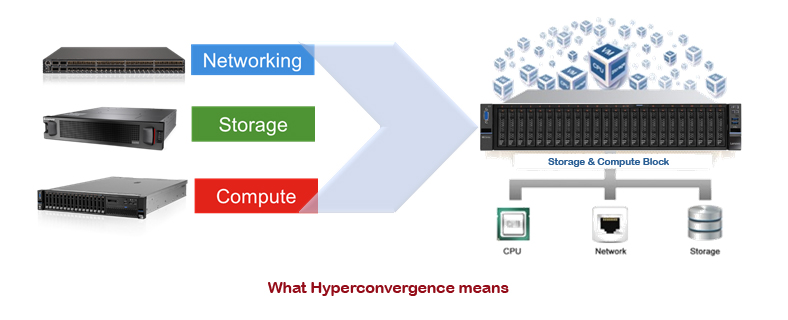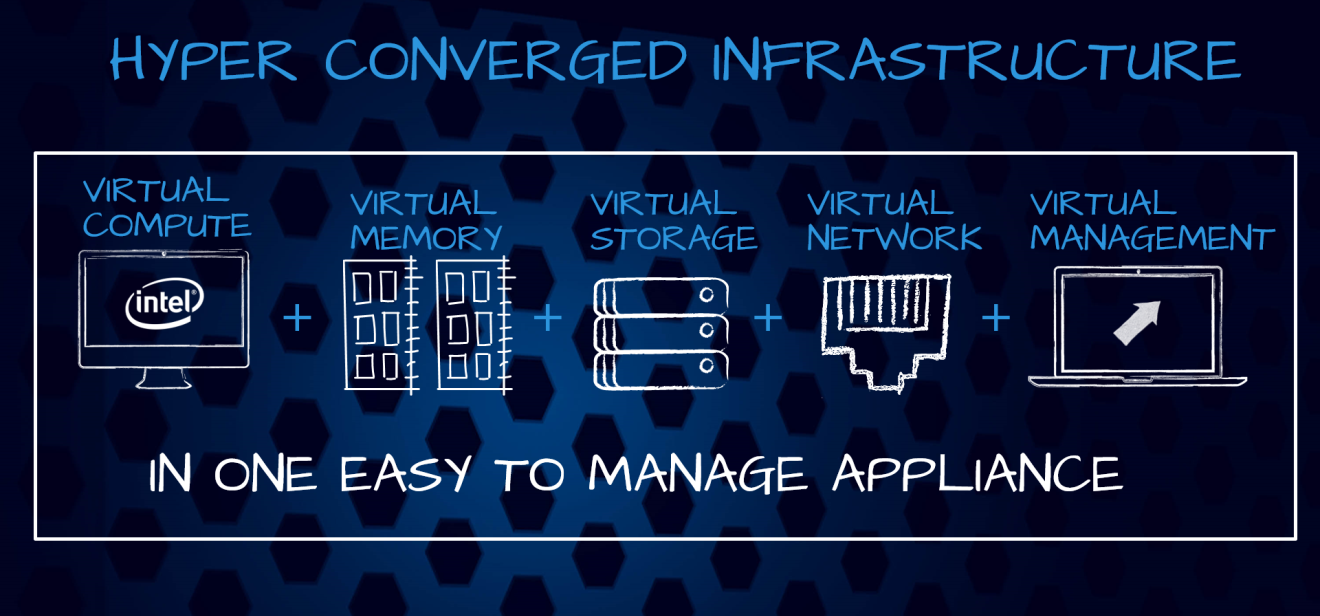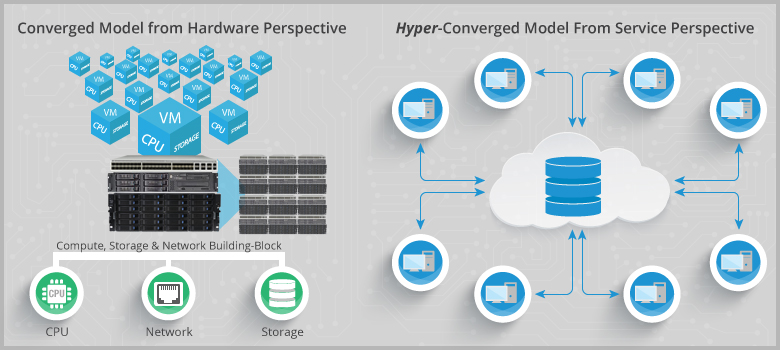
Defining ‘Hyperconvergence’
At the highest level, hyperconvergence is a way to enable cloud-like economics and scale without compromising the performance, reliability, and availability you expect in your own data center.

Hyperconverged infrastructure provides significant benefits:
-
Software Focus
Hyperconvergence is the epitome of the software-defined data center (SDDC). The software-based nature of hyperconvergence provides the flexibility required to meet current and future business needs without having to rip and replace infrastructure components. Better yet, as vendors add new features in updated software releases, customers gain the benefits of those features immediately, without having to replace hardware.
-
Use of Commodity x86 Hardware
Commodity hardware equals lower cost. The software layer is designed to accommodate the fact that hardware will eventually fail. Customers get the benefit of these failure avoidance/ availability options without having to break the bank to get the hardware.
Financial officers really like the opportunity to save a few bucks. The business gets to enjoy better outcomes than legacy data center systems offer, often at a much lower cost.
-
Centralized Systems and Management
In hyperconvergence, all components — compute, storage, backup to disk, cloud gateway functionality, and so on — are combined in a single shared resource pool with hypervisor technology. This simple, efficient design enables IT to manage aggregated resources across individual nodes as a single federated system.Mass centralization and integration also happen at the management level. Regardless of how widespread physical resources happen to be, hyperconverged systems handle them as though they were all sitting next to one another. Resources spread across multiple physical data centers are managed from a single, centralized interface. All system and data management functions are handled within this interface, too.

-
Enhanced Agility
Agility is a big deal in modern IT. Business expects IT to respond quickly as new needs arise, yet legacy environments force IT to employ myriad resources to meet those needs. Hyperconverged infrastructure enables IT to achieve positive outcomes much faster.Part of being agile is being able to move workloads as necessary. In a hyperconverged world, all resources in all physical data centers reside under a single administrative umbrella (see the preceding article). Workload migration in such environments is a breeze, particularly in a solution that enables consistent deduplication as a core part of its offering. Reduced data is far easier to work with than fully expanded data and helps IT get things done faster.
-
Scalability and Efficiency
Hyperconvergence is a scalable building-block approach that allows IT to expand by adding units, just like in a LEGO set. Granular scalability is one of the hallmarks of this infrastructure. Unlike integrated systems products, which often require large investments, hyperconverged solutions have a much smaller step size. Step size is the amount of infrastructure that a company needs to buy to get to the next level of infrastructure. The bigger the step size, the bigger the up-front cost.The bigger the step size, the longer it takes to fully utilize new resources added through the expansion. A smaller step size results in a far more efficient use of resources. As new resources are required, it’s easy to add nodes to a hyperconverged infrastructure.
-
Low Cost
Hyperconverged systems have a low cost of entry compared with their integrated system counterparts and legacy infra- structure.
-
Easy Automation
Automation is a key component of the SDDC and goes hand in hand with hyperconvergence. When all resources are truly combined and when centralized management tools are in place, administrative functionality includes scheduling opportunities as well as scripting options.Also, IT doesn’t need to worry about trying to create auto- mated structures with hardware from different manufacturers or product lines. Everything is encapsulated in one nice, neat environment.
-
Focus on VMs
Virtualization is the foundation of the SDDC. Hyperconverged infrastructure options use virtual machines (VMs) as the most basic constructs of the environment. All other resources — storage, backup, replication, load balancing, and so on — support individual VMs.As a result, policy in the hyperconverged environment also revolves around VMs, as do all the management options available in the system, such as data protection policies, which are often defined in third-party tools in legacy environments. With hyperconvergence, integrated data protection policies and control happen right at VM level.VM-centricity is also apparent as workloads need to be moved around to different data centers and between services, such as backup and replication. The administrator always works with the virtual machine as the focus, not the data center and not underlying services, such as storage.
-
Shared Resources
Hyperconvergence enables organizations to deploy many kinds of applications in a single shared resource pool without worrying about the dreaded IO blender effect, which wrecks VM performance.How does hyperconvergence make this type of deployment possible? Hyperconverged systems include multiple kinds of storage — both solid-state storage and spinning-disk — in each appliance. A single appliance can have multiple terabytes of each kind of storage installed. Because multiple appliances are necessary to achieve full environment redundancy and data protection, there’s plenty of both kinds of storage to go around. The focus on the VM in hyperconverged systems also allows the system to see through the IO blender and to optimize based on the IO profile of the individual VM.
-
Data Protection
To provide data protection in a legacy system, you have to make many decisions and purchase a wide selection of products. In a hyperconverged environment, however, backup, recovery, and disaster recovery are built in. They’re part of the infrastructure, not third-party afterthoughts to be integrated.The benefits of hyperconvergence are clear:Comprehensive backup and recovery, and affordable disaster recovery.Efficient protection without data rehydration and re-deduplication — and the inefficient use of resources that result.A single centralized console that enables IT to respond quickly.
-
Single-vendor benefits
Single-vendor design, delivery, and support are also features of hyperconvergence. Customers get one point of contact for the life of the system, from initial inquiry to system stand-down. Because hyperconverged systems are tested, customers have less need for pilot projects, and those that choose to run them can do so for shorter periods.In a hyperconverged system, there is only a single manufacturer and only one upgrade to be done. Reduced complexity in these processes translates directly to saved time and lower operational costs.A single-vendor approach provides economies of scale in procurement, operations, and support.

The top 7 hyperconvergence use cases
Consolidating servers and data center
Are you tackling a new consolidation project or building a new data center? Leading hyperconvergence vendors provide products that integrate seamlessly with your existing environment. The right hyperconverged solution can solve your immediate challenges and produce major benefits.
Modernizing technology smoothly
The beauty of hyper- convergence is its nondisruptive implementation. The hyperconverged environment is part of your overall environment, so you can phase in new architecture while you phase out the old, implementing and expanding as funds allow. If applications in the legacy environment need the storage performance provided by the hyperconverged environment, they can leverage those resources.
Deploying new tier-1 applications
Is your existing environment suitable for new tier-1 workloads? Rather than simply throwing more resources at an outdated environment, deploy the new workload in a hyperconverged environment to gain the inherent operational benefits. As time goes on, you can start bringing the rest of your infrastructure into the same architecture with easy-to-add, LEGO-like efficiency.
Deploying VDI
Resource islands are established in large part due to virtual desktop infrastructure (VDI) needs. However, the way that IT implements these resource islands means that they’re forever separate. By deploying your VDI project in a hyperconverged infrastructure, you don’t face resource challenges that require you to create these islands. When the VDI project is out of the way and the rest of your environment becomes eligible for renewal, you can slide everything to the hyperconverged environment with ease.
Managing sites remotely
In a hyperconverged environ- ment, the entire infrastructure is controlled by a single management system. Remote resources can be managed as though they were local resources. There’s no need to have remote personnel perform manual operations such as running backup jobs or creating logical unit numbers (LUNs) or quality-of-service policies. The data efficiency technology allows backups to be simplified in the remote office and offsite copies to be automatically sent to headquarters, another remote office, or even the cloud. This enables centralization of administrative resources, providing staffing economies of scale.
Performing testing and development
Many organizations operate test and development (test/dev) environments so that bad code isn’t released into production. Hyperconvergence supports test/dev and production needs, with management tools that can help you create logical separations between these functions. Unfortunately, many organizations give short shift to test/ dev and run it on lower-class hardware, which doesn’t really make sense. This greater IT agility will keep developers in house instead of building their own Shadow IT in the public cloud.
Modernizing backup and implementing disaster recovery
If you don’t do a good job with either backup or disaster recovery, run — don’t walk — toward hyperconvergence as your infrastructure architecture. Hyperconverged infrastructure eliminates the complexity that can be inherent in these operations. In IT, simplicity is the new mantra, and hyperconvergence is one of the simplest ways to achieve your backup and disaster recovery goals.

Recent Comments